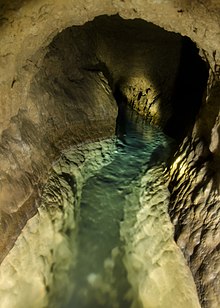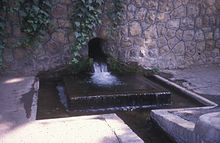
Back Qanat ALS Canyo (construcción hidraulica) AN قناة (ري) Arabic قناة رى ARZ Kəhriz Azerbaijani Ганат Bulgarian Qanat Catalan Kanát Czech Kareze Danish Qanat German
This article may require cleanup to meet Wikipedia's quality standards. The specific problem is: the talk page mentions that there is content overlap with Traditional water sources of Persian antiquity. (August 2022) |

A qanat or kārīz is a system for transporting water from an aquifer or water well to the surface, through an underground aqueduct; the system originated approximately 3,000 years ago in Iran.[1] The function is essentially the same across North Africa and the Middle East but the system operates under a variety of regional names: qanat or kārīz in Iran, qanat in Malta, foggara in Algeria, khettara in Morocco, falaj in Oman and the United Arab Emirates, karez in Afghanistan and Pakistan, uyūn in Saudi Arabia, etc.[1] The largest extant and functional qanat systems are located in Iran, Afghanistan, Oman, the oases of Turfan region of China, Algeria, and Pakistan.[1]
This is a system of water supply that allows water to be transported over long distances in hot dry climates without losing much of the water to evaporation. The system has the advantage of being resistant to natural disasters, such as earthquakes and floods, and to deliberate destruction in war. Furthermore, it is almost insensitive to the levels of precipitation, delivering a flow with only gradual variations from wet to dry years.
Karez are constructed as a series of well-like vertical shafts, connected by a gently sloping tunnel. This taps into underground water and delivers it to the surface by gravity, without need for pumping. The vertical shafts along the underground channel are purely for maintenance purposes, and water is typically used only once it emerges from the daylight point.
The qanats still create a reliable supply of water for human settlements and irrigation in hot, arid, and semi-arid climates, but the value of this system is directly related to the quality, volume, and regularity of the groundwater. Much of the population of Iran and other arid countries in Asia and North Africa historically depended upon the water from qanats; many populated areas are close to the areas where qanats are possible.[2]


© MMXXIII Rich X Search. We shall prevail. All rights reserved. Rich X Search